A guest post by Australian true crime writer Stephen Karadjis
On July 9, 1976, 12-year-old schoolboy Garry John Barkemeyer was lured to a desolate spot near Jubilee Oval in Glebe, Sydney, Australia. He was sexually assaulted and bashed to death. Just 7-months later, on January 30, 1977, 12-year-old Wayne Spencer Nixon was assaulted in a similar manner and stabbed through the heart. Several weeks later, Mark Gregory, a 17-year-old youth, was arrested and charged with both murders. In March 1978 the offender was convicted and sentenced to two life terms of imprisonment.
The circumstances surrounding these events have long faded from the public’s memory. Both boys’ lives were cut tragically short. Neither ever had a chance to grow-up. This story is a personal account. I attended high school with the killer and we were in the same class.
Enmore Boys High School
Although it was more than 40-years-ago, the encounters I had with him are burnt forever into my memory. It was 1976. We were in the playground of our high-school annex. This building, which housed the rooms where students went for subjects including art, wood-work, metal-work, technical drawing and industrial-arts was a short walk up the steep incline of Metropolitan Road from the main school complex.
I remember feeling the most excruciating pain in the centre of my back. I recoiled by arching my shoulders immediately on reflex. At the same time, I screamed out in agony. Mark Gregory had planted his knuckles with a force and viciousness where he knew it would inflict the most damage – right on the backbone. It was enough to bring 3-classmates running to my aid.
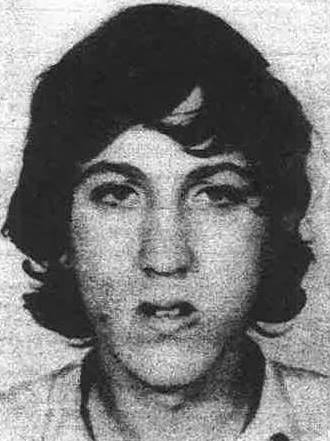
Source: NSW State Library
A group stood watching him in a semi-circle. He showed them no fear. There was no flinching. One stood facing him. Gregory, the aggressor, stared directly back at him with that deadpan look in his eyes. He was gangling in appearance and taller than them, though only slightly. An exchange of words ensued. Two of my mates echoed one another. “What do you think you’re doing Gregory?” said the first, in a harsh, serious tone.
The second was just as earnest as he delivered almost the same line, only in a more controlled and arbitrary manner, “Hey Gregory, what do you think you’re doing mate?” A third classmate was standing by.
The first boy, Paul, was standing close into him, their faces inches apart, as Mark Gregory replied with mock laughter in his voice, “Oh, what’re you gonna do?”
“What am I going to do? Why don’t you try something, and you’ll find out! Why don’t you leave him alone?” asked Paul.
“I’ll leave him alone when I’m good and ready,” replied Gregory.
“But when are you going to stop, Mark?” I shouted, in desperation.
He stood firm, turning only his face to the left-side as he glared down upon me and hollered in a monotone, “I’ll stop when I frickin well feel like it.”
I was among the shortest boys in our year out of a group of about 120 students, and only slight in build. He had been stalking me at school for the best part of 2-years and his modus operandi was to approach me surreptitiously from behind. I was fortunate to have quite a few close friends who were never far away.
My plea for mercy gave courage to my classmate, who up until this moment had been standing by and observing the standoff. With some noticeable trembling in his voice, he blurted, “Oh, come on Gregory, he’s half your size mate.”
That was about all there was to it. He left school around this time and may have already murdered 12-year-old Garry Barkemeyer when this altercation took place.
The Murder of Garry John Barkemeyer
Garry John Barkemeyer, 12, lived with his mother Hildegard, 44, at the Elsie Women’s Refuge in Derwent Street in Glebe. On Friday afternoon July 9, 1976, two-children were playing in Doctor Foley’s Rest Park on the corner of Glebe Point and Pyrmont Bridge Roads. The boys, aged 12 and 8, were approached by a man wearing a yellow pullover, grey trousers and blue joggers with white stripes. He was lanky in appearance, of fair complexion with collar-length brown hair. The younger of the boys, later told detectives that he thought the man was aged between 23 and 30 years.
The man asked them whether they would like to earn a few dollars by helping him stack some boxes in Jubilee Oval. They agreed, and the man said he would meet them there.
The two boys rode off in the direction of the park, doubling on a bicycle, eager to earn a bit of pocket-money. When they rendezvoused half-an-hour later, the man told the younger boy to wait while he and the older boy attended to the boxes.
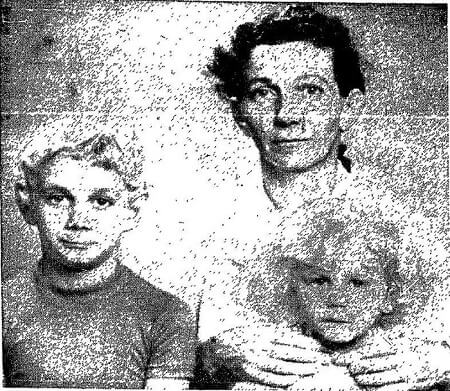
Garry Barkemeyer.
Source: NSW State Library
The man then led the way around to the other side of a railway-line used for shunting goods. At this section of line, a viaduct supported the train-tracks above.
A short time later, the man emerged and told the younger boy that he had given his playmate the money and he had gone home. He told the younger boy that he should also go home.
Mrs. Barkemeyer reported her son missing on Sunday, July 11. The following afternoon the mother of the younger boy called the police, when her son said that Garry had not been to school that day. The 8-year-old playmate, Julian, led Detective Sergeant Bruce Bell along with 3 other officers, to a spot overgrown with dense blackberry vines and native vegetation. They came upon the small body of a child. It was evident that he had sustained multiple skull fractures having been bashed to death with a large, heavy rock. It was the scene of a truly violent act. The boy was only small. His clothes were in disarray and it was thought by police, that they were now looking for a sadistic, sexual deviant.
On Wednesday, July 14, an identikit-picture of the suspect was published. The following day, a police-field-unit caravan was set-up on Federal Road near the park and a constable was manning two-telephones and relaying information back to detectives at Glebe police-station. Then, on Friday, a week after the body of the slain boy was found, the Sydney Morning Herald ran a story, announcing that police had received new information from a witness.
This man had been testing a car for road-worthiness on Friday afternoon, when he spotted an individual lying on the grass in Jubilee Park. After he saw the identikit-picture in the newspaper, he came forward, confident it was the same person wanted by Glebe police. He provided a vital clue on the age of the suspect. He claimed that the man in question, could be as young as 18, but no more than 23 and was about 180cm (5ft 11” tall).
Following this breakthrough, thousands of printed-pamphlets were circulated in Glebe. The flyer contained information relating to the circumstances of the child’s disappearance, where the body was discovered, the clothes he was wearing and a detailed description of the suspect along with the identikit-picture.
On Monday, July 19, police sought the assistance of the public, with a renewed appeal for any information. It was estimated there were about 20 joggers in the park that Friday afternoon. Police suspected that witnesses might be reluctant to contact them, fearing possible implication in the crime itself. They emphasized that all calls would be treated in the strictest confidence.
Nevertheless, telephone calls began to dwindle to only a trickling. The final newspaper article was a funeral notice for the victim, relaying that a service had been held the day before at the Methodist Church on Toxteth Road, Glebe and mentioning the hearse leaving later for Rookwood Cemetery.
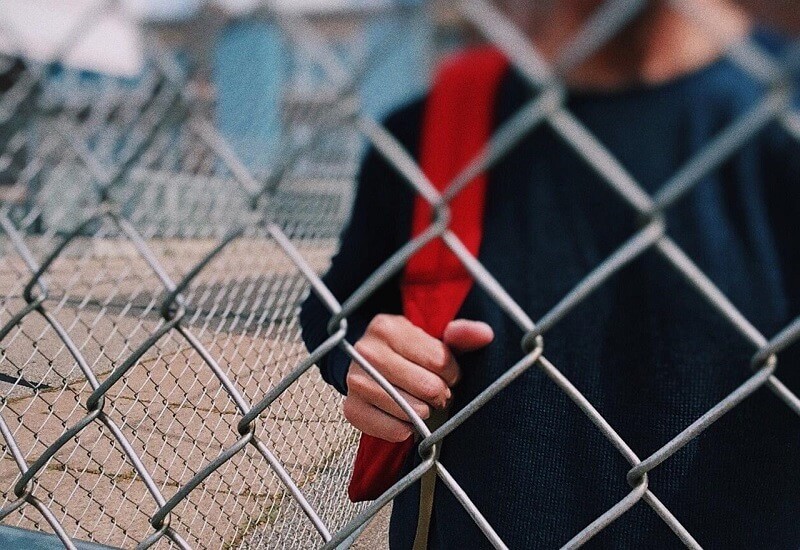
Enmore Boys High School
At the time of the altercation in the playground of our high school annex in the middle of 1976, when I was punched in the back from behind and my friends ran to help me, I could not recall having seen Mark Gregory for quite some time. He had most likely left school at the end of 1975. I believe he showed up that day to find me. After this incident I never again saw him at Enmore Boys.
The next time I saw him, it was late January 1977 and the start of another school year. We had only just returned from the long summer holiday-break. Classes had concluded for the day. As I was walking down the front steps of Enmore Boys High, I gazed directly across to the other side of Edgeware Road and clapped eyes on him. He was striding gallantly along the footpath with a much younger boy in-tow. The two seemed to be heading in the direction of Enmore Park. His behaviour was animated. He was posturing with his arms as he was talking to the smaller boy who appeared to be completely under his spell. There was an obvious difference in age and height between the two. Mark Gregory looked to be about a foot taller. The incongruence was somewhat bizarre and puzzling to me. But I dismissed it quickly, being a flighty teenager.
The small boy was Wayne Spencer Nixon. I knew him only by sight. I did not know his name. On weekday mornings, schoolboys were picked-up by the brown and white coloured private bus line that wended its way between Rozelle and Rockdale. I caught this bus at the corner of Parramatta Road and Catherine Street, Leichhardt. Wayne Nixon came aboard further along, either in Stanmore or Camperdown. He would always come to the back of the bus and hoist himself up onto the side seat which was elevated above one of the bus’s rear wheels. He was always smiling and spirited and seemed happily inclined. As he was only in primary school, he stood out from the usually packed busload of high school students. I remember he had wavy blonde hair which he wore collar-length and dressed most often in grey school-shorts.
The Murder of Wayne Spencer Nixon
Wayne Spencer Nixon, 12, lived with his mother, Mrs. Hazel Gurney, and sister, Nina, 16, in Kingston Road, Camperdown. He had two stepbrothers, Robert, 32, and Dennis, 31. He was said to be a fun-loving boy with plenty of friends and was about to begin his first year at Newtown High School. His life was cut short.
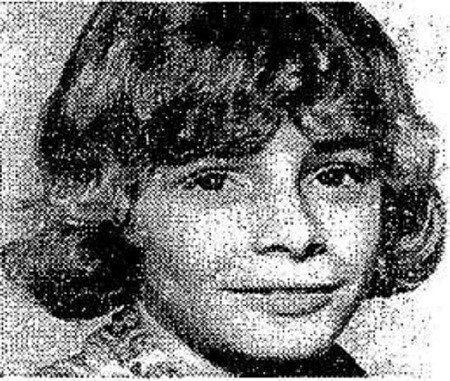
Sydney Morning Herald, February 02, 1977.
Source: ActivePaper Archive, NSW State Library
On Monday, January 31, at 6 pm, an anonymous call was received by Brian Anderson, a reporter working for ATN Channel Seven.
A man, who did not identify himself, asked to speak with prime-time newsreader, Roger Climpson. After being advised that he was not available, the caller told the reporter that the body of a boy had been found where Garry Barkemeyer was killed six months earlier.
Mr. Anderson, later said that, “I told him I would check with the police,” to which the man replied, “Go ahead and check because it is true.” Mr. Anderson went on to say – “The call lasted about a minute. The man sounded calm.” He guessed the caller was about 30-years-old or younger. This was the first of two anonymous calls that Glebe police received about this case.
Shortly afterward, detectives located the body on an embankment alongside the Glebe goods railway-line. The child, a young boy, was lying face-down in thick scrub, pressed-up against a paling-fence that separated the train-line from a municipal council car-park and grassland. On the other side of the tracks was Jubilee Oval. It was later reported that the murder had occurred on Sunday afternoon at the time a cricket-match was underway and when neighbouring residents were walking their dogs.
Glebe police surmised that the same person was responsible for both murders. The similarities extended to the ages of the boys, the location and position of the bodies and the removal and disarray of their clothing. Both had met a violent death and were sexually assaulted.
The crime scene was sealed off immediately from public scrutiny and possible contamination. A demountable field unit was then set-up, equipped with flood-lights and tents to enable ease for an all-night investigation. The victim was driven away to the city morgue later that evening.
The results of a scientific examination revealed that Wayne Nixon had been stabbed in an arm, a leg, and several times in the chest cavity including one deliberate thrust which had penetrated deeply through the heart. It was determined that a 12.5cm long knife had been used. Despite an intensive search, the murder weapon was never found. The killer had discarded the knife in a rubbish-bin.
On Wednesday, February 1, detectives, seeking clues to the murder, made a house to house search.
After interviewing the family and a neighbour, detectives quickly established a chronology of events that placed the victim at specific locations throughout Sunday, January 30.
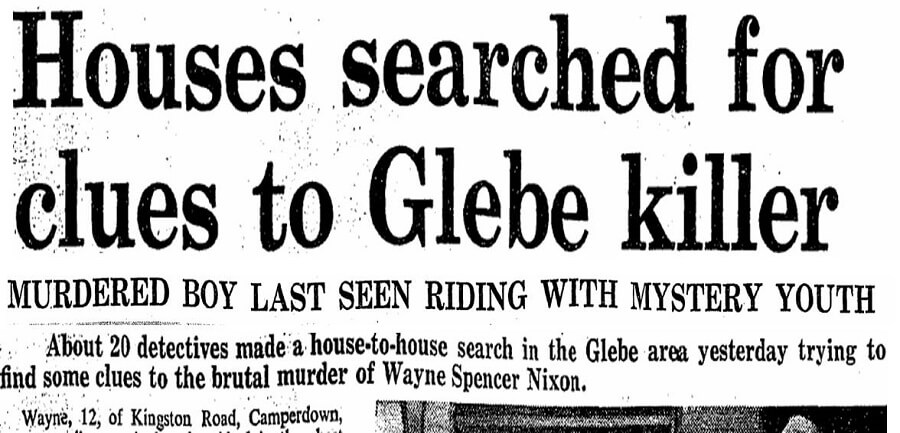
Source: ActivePaper Archive, NSW State Library
Mrs. Hazel Gurney, Wayne’s mother, told police that her son had set out to go swimming on Sunday morning at Leichhardt Municipal Pool. It was later learned that he had gone swimming at a friend’s place, returning home for lunch at 2 pm. Afterwards, he had watched television and then left to see a friend. But this friend, Tony, had gone to the beach that day. Stepbrother, Robert, thought that Wayne might have gone to Thistle Park to bide his time and wait it out until his friend returned home.
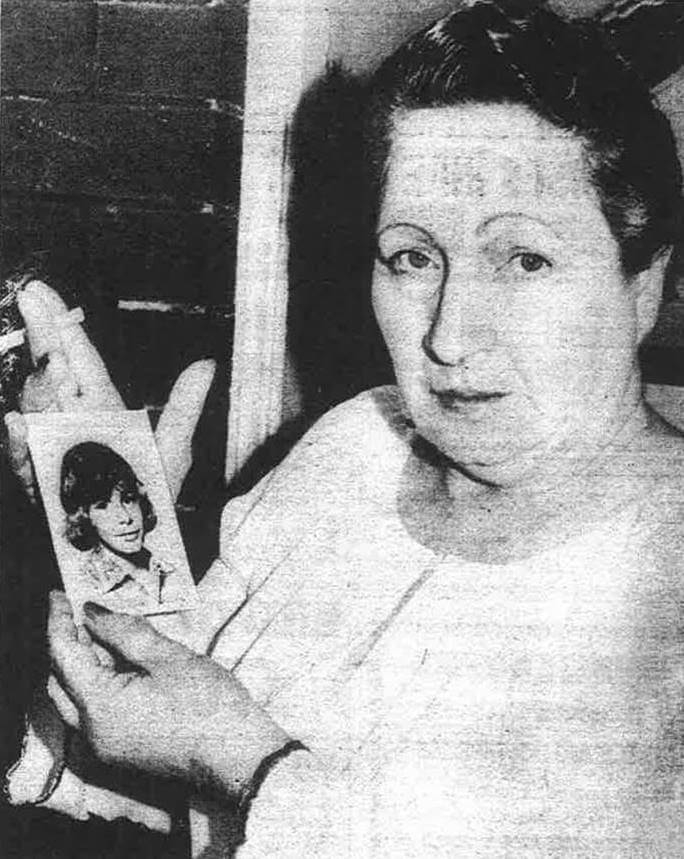
Source: NSW State Library
At about 3 pm, a neighbour spotted Wayne in the company of a youth in Cardigan Street, Stanmore. They were riding-double on a bicycle. She recalled that Wayne had waved to her, where upon she heard the youth remark, “Who the hell was that?” She later described him as being about 16-years-old with collar-length brown hair, olive skin and wearing orange shorts and a pair of thongs. This was the last confirmed sighting of Wayne Nixon.
The victim’s bicycle, which his mother had given him on his birthday, the previous September, was still missing. It was purple in colour with an olive-green transistor radio tied to it.
The victim’s mother, Mrs Gurney, commented that she doubted Wayne had accompanied the youth willingly. His stepbrother Robert said, “Wayne was not the sort of fellow to go off with anyone. To have gone off with this youth, he must have known him for a period-of-time somewhere.”
By Wednesday afternoon a mental patient from nearby Callan Park came across the missing bicycle, a purple “dragster”, in shallow water in the Parramatta River at Iron Cove, about two-kilometres from the murder site. It had obviously been discarded, either rolled down the embankment or thrown into the river. The discovery prompted detectives to interview patients in Callan Park who were given leave privileges on Sunday. However, the investigation at the hospital was terminated when it yielded no result.
The transistor radio had already been found by a 13-year-old boy in the river at White Bay about 500 metres from Jubilee Oval. Police divers had also scoured the river-bottom in vain, looking for the knife used by the killer.
A youth was seen wheeling the bicycle through Rozelle on Sunday afternoon. However, the description of the individual given to police, did not match-up with that of the youth seen doubling the victim on the bicycle.
At this point, there was a renewed appeal to the public by detectives, to contact either Glebe police station or the Special Crime Squad at the CIB headquarters in Surry Hills.
By Saturday, February 5, detectives had formed the view that Wayne Nixon had met his killer at Leichhardt swimming pool. They had established that he had left home at 9:30 am on Sunday morning. Along the way, they believed that he met with a friend and they went for a swim and later the boys returned to the friend’s home at 12:30 pm. While at the pool he had most likely spoken with someone and they had arranged to meet later in the afternoon.
The house to house search in Glebe, now extended to the suburbs of Rozelle, Camperdown and Leichhardt and 60-detectives were door-knocking in an all-out manhunt.
In the meantime, a funeral notice for Wayne Spencer Nixon was announced in newspapers. Relations and friends were invited to pay their last respects and sign a book of condolence in the chapel of T.J. Andrews, funeral directors, 25 Enmore Road, Newtown, between 5 pm and 8 pm on Sunday, February 6. The funeral procession was to leave the chapel at 10:30 am on Monday morning for the Northern Suburbs Crematorium, and a service held there at 11:40 am.
Enmore Boys High School
A series of seemingly unrelated coincidences connected me to Wayne Nixon, not the least of which, was that I was singled-out and targeted with vindictiveness by Mark Gregory. But more about that later.
On the day he was murdered, Sunday 30th January, my mother Norma was waiting for the bus on Parramatta Road, near the corner of Catherine Street Leichhardt. She was to start a shift that day at the National Telephone Exchange where she worked as a telephonist for Telecom Australia (now Telstra) located in Dalley Street in the city. There were not many people around on that lazy Sunday, and as she was standing on the footpath outside the women’s clothing store, Belle Star, she saw 2-boys, one noticeably bigger and older than the other, cross Parramatta Road directly in front of her. One was walking with a bicycle. The older boy seemed to be in a hurry. He turned to the little boy with some annoyance and yelled, “come on, hurry-up.” There was a sense of urgency in his voice. They were on their way to Jubilee Oval in Glebe. This was the second occasion Mark Gregory was resolved on luring another little boy to his unsuspecting demise.
Even though news of the murder of Wayne Nixon was flashed across our television sets, my mother later told me that, at the time, she did not relate the boy she saw crossing Parramatta Road to the news of the murdered boy.
About a week prior to his arrest, my mother and I crossed paths with Mark Gregory outside the shops on Parramatta Road, Annandale. This was near the corner of Johnston Street. It had been about 5-weeks since my mother saw the boys crossing the road. My mother recognised him as a boy our family had run into at Bronte Beach the previous summer of 1975- 1976. I had not seen him for some time and for some reason I called out to him. He stopped in his tracks and we had a brief conversation as my mother looked on. I asked him what he had been doing since leaving school. He told me he was working as a storeman in Permewans Food Store, a supermarket-chain that existed at the time. He pointed behind to the shop. I remember the television commercial which advertised Permewans Stores. It had a catchy jingle to it and went like this – “There’s something about Permewans Stores, make savings every day.” I sometimes sing these couple of lines that I remember and relate the sadness which surrounded the murder of both boys.
When it was announced on the evening news that a 17-year-old youth had been arrested “and charged with the murders of Wayne Spencer Nixon and Garry John Barkemeyer,” I knew it was him. There was news footage showing the shop-front of the supermarket. It was only after Mark Gregory had reached the legal age of 18 that he was named as the killer.
The Arrest of the Accused
Finally, on Thursday, March 17, 1977 detectives’ painstaking efforts yielded results when a 17-year-old youth was arrested and charged with the murder of Wayne Spencer Nixon.
On Friday, March 18, he stood in the dock before Special Magistrate, Mr. R.D. Blackmore in the Metropolitan Children’s Court in Albion Street, Surry Hills. The youth was represented by Mr. Fred Anderson, a duty-solicitor for the Law Society’s Legal Aid Service. The Press were granted permission to listen to the proceedings and report on the matter, on the explicit understanding that the name and address of the youth be suppressed due to his age. He was still a minor in the eyes of the law.
The police prosecutor, Sergeant Barry York, gave evidence that the accused had met-up with 12-year-old Wayne Nixon at Enmore swimming pool on Sunday, January 30 and afterwards they doubled on the victim’s bicycle, across the suburban-sprawl, to Jubilee Oval in Glebe where the boy was stabbed to death. On opposing bail, Sergeant York said, “He is charged with a very serious offence. He made certain admissions and signed a record of interview.”
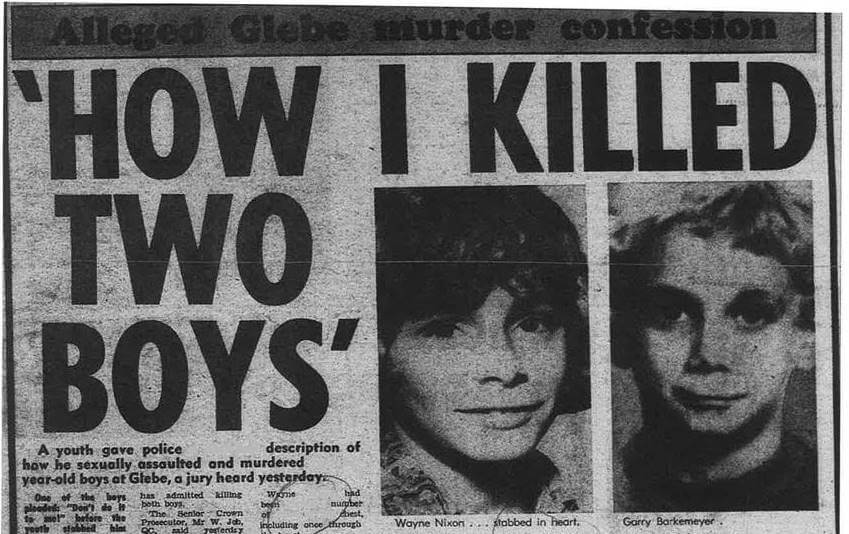
Source: NSW State Library
The magistrate concurred after which he remanded the youth to the Metropolitan Boy’s Shelter, in Albion Street, Surry Hills. The same evening Glebe police charged the youth with the earlier murder of Garry John Barkemeyer.
On Monday, March 21, the defendant was again brought before the magistrate. This time he was represented by Mr. J. Cobin who entreated His Honour that the Press be excluded from the court-room. The accused had confided to his counsel that he felt he had been prejudiced the previous week when reporters had pencilled sketches of him which were later detailed on television and in newspapers. However, Mr R.D. Blackmore was disinclined to agree. He believed it was in the public interest to report on the matter but again warned reporters not to publish the name and address of the youth as the accused had not yet attained the legal age of 18. The police prosecutor, Sergeant J. Newling, asked that the matter be adjourned to Friday. The defendant did not apply for bail and he was remanded in custody to the Children’s Shelter.
On Friday, March 25, the defendant was returned to court to be advised of the date of his committal hearing. The solicitor for the youth, Mr. J. Cobin agreed to submissions from Sergeant John Broadfoot and the case was adjourned to June 14.
On June 14, 1977, the committal hearing commenced on schedule in the City Court of Petty Sessions in Glebe, where evidence was given before Special-Magistrate, Mr. N. Stackpool.
Detective-Inspector Harry Tupman of the Criminal Investigation Bureau (CIB), Homicide Squad testified, that on March 17, 1977, he and other detectives had spoken with the defendant at a supermarket in Parramatta Road, Annandale. He had asked the youth to show him the place where he had murdered Wayne Nixon and the route they had taken on Sunday, January 30. On March 18 the youth led detectives to a spot in Enmore Park, where he said he had found a knife which he later used to stab the victim. He also showed them a lane where he had rendezvoused that day with the 12-year-old.
Nina Nixon, the victim’s 16-year-old sister, told the police prosecutor, Sergeant Bennett, she had been a customer at a newsagency, when she first met the defendant working behind the counter. Later, as she was waiting for a taxi-cab with Wayne and her mother, he was standing in the doorway of a hotel. He had said, “Hi”, where upon Wayne said he knew him and said hello in response.
A witness, Carlos Lorenzo, 15, of View Street, Annandale also provided a revealing vignette. He said he had come upon the missing bicycle at the water’s edge in Rozelle Bay and had removed a brake-cable and one of five elastic-stretchers used for harnessing purposes. Returning to the spot the next day, he had observed a man carry the bicycle and load it into the boot of a car and drive away.
The bicycle was dumped afterwards, once again in the water in Iron Cove, where it was discovered by a mental patient who then alerted police.
On Monday, June 20, Detective-Sergeant Colin Hodgkinson of the Homicide-Squad testified that on March 18, 1977, he had questioned the youth. He advised him of a witness who had identified an individual matching his description. He said that on July 9, 1976, this witness saw the individual approach Garry John Barkemeyer and a playmate in Doctor Foley Rest Park. The detective then asked the youth to take part in an identification parade. It was then that the youth confessed to the murder, stating with frankness, “I don’t want to go in one of those. I will tell you what happened, I killed him. I bashed him on the head with a rock.”
Senior-Constable Mervyn Cook told the court he had been station sergeant at Glebe Police Station on January 31, when he took two telephone calls. The first came in at 5:10 pm reporting a body in Jubilee Park and the second at 6:15 pm with information that a man had been seen in Johnston Street, Annandale, with blood on his shirt. Senior-Constable Cook added, that the anonymous caller said he was the same person who had phoned earlier. The caller gave a description and residential address for the suspect.
It was announced in the Sydney Morning Herald on Thursday, June 23, 1977 that following the testimony the day before, the 17-year-old youth was committed to stand trial in the Central Criminal Court in Liverpool Street, Sydney on charges of murdering two 12-year-old boys in Glebe.
Enmore Boys High School
Mark Clifford George Thomas Gregory, started his high school education at Enmore Boys in 1973. He was in my class. I remember on one occasion he fell asleep and the teacher’s hand came down upon him with a swoop. He was startled and yelled out with vehemence in an obvious show of anger and defiance about receiving this unexpected and humiliating corporal-punishment. With hindsight, there was obviously some trouble and it was not the last time he fell asleep during class-time. In that first year, there was never any problem between us. His vindictiveness towards me was borne out of an unfortunate incident that took place in the second half of 1974, the blame of which rested entirely with me.
In those days, Enmore Boys High School held their annual athletics carnival over two days. The first was an informal picnic-day at Lane Cove National Park. Teachers and pupils alike, boarded a succession of buses which arrived outside the front-face of the school, lining Edgeware Road and trailing one behind the other.
Once at the grounds a true carnival ambience spread, with row-boat-rides for the pupils, three-legged races with teacher’s participation, along with some running events, mostly sprints. Students brought with them a packed-lunch and barbecue areas were utilised and there were soft-drinks aplenty. It was a full-day and gave everyone the opportunity to relax and have fun.
When the buses arrived that afternoon for the return journey, there was an unholy rush for seats. By the time I ascended the couple of steps and was inside, it was standing room only. We were squashed into the crowded aisle. Mark Gregory was also standing with two or three boys wedged between us. I cannot recall what precisely happened next. I think he was talking loudly and dissenting and being a typical teenager with little forethought to my actions, I hit him over the head with my small rucksack. His back was towards me at the time. He turned swiftly and glared about with hostility to locate the guilty party. He eventually fixed his wild, penetrating eyes on me, knowingly. He lashed out immediately with his long arms trying to grab hold of me, but I was out of reach. “Your (expletive) dead”, he warned with a steely resolve.
Incidents between pupils occurred most of the time and usually all was forgotten no later than a few days on. But with Mark Gregory, it turned into a personal vendetta and he would not let it go. So, for the next two years I was always looking over my shoulder. There were several scrapes between us, culminating in the incident in the playground of our high school annex.

The Trial of Mark Gregory
Due to his pleas of not guilty on both counts of murder, a trial was inevitable. It began on Monday, March 13, 1978. In the court-room, His Honour, Justice Yeldham presided over the proceedings.
On Tuesday, March 14, the Sydney Morning Herald published the name of the accused. He was Mark Clifford George Thomas Gregory, 18, of Johnston Street, Annandale.
The evidence and testimony tendered in court was unmistakable, straight forward and transparent and the defendant ‘s guilt in the crimes was proven to be overwhelming. There were records of interview between police and the accused at the time of his arrest the previous year. Gregory had not only signed the paperwork but also described the murders in detail.
Senior Crown Prosecutor, Mr. R.W. Job QC, told the 12-man jury that Mark Gregory had confessed to the murders and admitted to committing homosexual attacks against both boys.
Mr. Job said that Garry Barkemeyer died from massive skull fractures after being hit on the head with a rock and that Wayne Nixon died after being stabbed through the heart. The Crown outlined the circumstances leading up to the murders in Jubilee Park.
Detective Sergeant A. McDonald, referring to the attack on Wayne Nixon, said that the accused had told him, “It was me that killed him. He fought a bit. I stabbed him. I really thought I would never be caught.” Gregory allegedly added, “I put my arm around his throat and I had the knife against his throat and I told him to get undressed. I had the knife and when he started to fight I stabbed him.”
It transpired, that the two anonymous telephone calls to police on the evening of Monday, January 31, 1977, were made by the killer himself. Mark Gregory, unwittingly had tried to thwart police in their investigation by passing on details which when later followed-up, led to clues which in turn were traced back to him.
Gregory had told police of seeing a man with blood on his shirt in Johnston Street, Annandale. He said he recognised the person as a Mr. Barry John Gay who lived in Robert Street, St. Peters. It was discovered that both Barry Gay and his son Barry Gay Junior had worked at a newsagency in Enmore Road. The manager of the shop informed detectives of an incident that occurred in the middle of 1976. There had been a fight outside the paper-shop between Barry Gay Junior and a 17-year-old youth named Mark Gregory. Apparently, Gregory’s father had gone into hospital at the time and Barry Gay had offered to take in Gregory’s younger sister. However, the situation did not work out and they asked the girl to move out. Gregory became belligerent that his sister was turned out while his father was in hospital. The matter led to Gregory harbouring ill-will against the family and his subsequent naming of Barry Gay Junior led to his own arrest.
The trial concluded on the afternoon of March 14, 1978, after 2-days. The jurors retired for only 70-minutes before returning with a verdict of guilty of murder on both counts.
Mr. Justice Yeldham gave a summary of the case with a few words of his own. He told the Central Criminal Court that as Mark Gregory had been under 18 at the time of the offences, a life sentence was not mandatory, adding he would give considerable thought to the sentences he would pass. He instructed there be psychiatric reports undertaken as well as reports from Probation and Parole and Youth and Community Services. His Honour commended the diligence of police under the leadership of the officer-in-charge of the Homicide Squad, Detective Inspector H. Tupman. He also credited police in their painstaking efforts and for treating the suspect with due fairness. He asked that his comments be forwarded to the Commissioner of Police, Mr. M. Wood.
On Thursday, March 30, 1978, the convicted 18-year-old stood in the dock of the Darlinghurst District Criminal Court. Mr. Justice Yeldham handed down two terms of life imprisonment to Mark Gregory for the murder of 12-year-old Garry Barkemeyer in 1976 and murder of 12-year-old Wayne Nixon in 1977. The convicted murderer gripped the railings of the dock with both hands and stared down at his feet with closed eyes.
His Honour told the court that the crimes were of such enormity that he could find no mitigating circumstances warranting mercy. He said that Gregory had shown no mercy to his victims and that the murders he committed were brutal and callous. The judge said that the first duty of the court was to ensure the protection of the community and guarantee the killer was not given the opportunity to kill again. He said that, in his opinion, Gregory would be a danger to others for a long time and that this view was reinforced by psychiatric reports. He further recommended that Gregory be sent to an appropriate maximum-security prison and continue to receive intensive therapy.
Epitaph
My memories of him and of those events remain as vivid today as they were at the time they took place.
Twelve-years earlier, when I was 6-years-old, my parents rented a house at 1 Edna Street, Leichhardt. The property was located on a corner next to a small reserve. There was a lovely house situated directly across on the opposite corner at 2 Edna Street. The paling-fence of the yard of this property, ran along the footpath of Ilka Street. My elder brother and I used to look through the breach between the palings of the fence and would often see a little boy sitting and playing in a cabana, the roof of which was overgrown with a copious green vine. The boy was about 2 years old. My parents moved us into this residence about 6-months later, after the family with the little boy had vacated it. When Wayne Nixon was murdered, my mother told me that he had been the little boy living next-door.
Our family lived at 2 Edna Street, Leichhardt from August 1966 through to May 1971. I still have, in my possession, a wooden coat-hanger which had been left behind by the previous tenants. Burnt into the wood is the name – S. Nixon (Spencer Nixon).
I can still see Wayne Nixon as the happy and innocent 12-year-old boy on our school-bus.

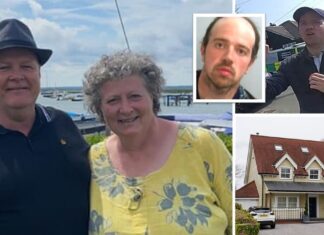








Mark Gregory lived around the corner from me in the 60,s. he would bully everyone that had to pass by the house he lived in. He was in my brothers class at St Marys north Primary,. The house he lived in with his father an siblings had hardly any furniture in it. The kids were never allowed to have friends over as Mr Gregory would go right off.
Hey Kate
Funny how we remember these things. I know now there were problems stemming from years before. It’s awful though he went on to murder two small children. He was obviously very disturbed.
Thanks Stephen for this article. I grew up in Glebe, a short distance from where these poor boys were found. I was only 8 at the time but remember some things like it was yesterday. Like the night my brothers and I walked right past him after footy training at Jubilee Oval. And when my brothers came home from school and met me at the door with the words, “there’s been another murder”. I was one of several local kids who were rounded up by reporters and appeared on tv that night.
It was a horrific time but I only ever understood it through the eyes of a young boy. And with the passing of time, the actual truth of what happened became less, not more, clear. I’ve tried in vein over the years to find information about these events, and this horrible person, but could find virtually nothing. Your article, being such a personal account, but also full of details of what actually happened, has really helped put all the pieces of this weird puzzle together. Thanks for writing it and thanks to this website for publishing it.
And a footnote…
Don’t know if any part of this is true or not, but I’ve heard his older brother dobbed him in after he saw his brother wearing a necklace with a very personal memento of one of the victims. Out of respect I won’t say any more. Did you hear this and know if there’s any truth to it? Either way I hope the sicko rots in hell.
Hi Alex
I don’t know of Gregory’s brother informing police. Apart from my personal involvement and attending school, most of the details I found researching the archives in the State Library.
I did receive an email telling me that Gregory was released from prison after only 6-years. There was an early release programme commissioned at this time by the state parliament of then NSW Premier Neville Wran. I don’t know if his being released is true but the person who told me was sincere.
Hi Stephen
I appreciate your article on the murders of 2 innocent young boys. I want to keep this short, it is to up setting to talk about. I am a 67 year old male. My name is Robert Bruce, Wayne Spencer Nixon was my brother. You see I was adopted at birth by my mother Hazel Gurney. I was and still registered with the salvation army adoption register. Seven (7) years ago I received a call from the Salvation Army advising me that they found my mother(Hazel) which is in that paper clipping but she he had passed. They were 5 siblings, 4 living , 1 passed (Wayne) he had been murdered at the age of 12. We also now have another sibling which was adopted who has found us 2 years ago. It is true, Gregory was released given false Id, finger prints ect and then put somewhere in protection. I cant understand how a murderer on 2 life sentences gets early release after 6-8 years and gets protected by the Australian Government. If it could be possible i would like to see the case reopened and Gregory or who every he is finish his jail term and have his last breath in prison. You may be able to put me in the right direction to speak to someone about reopening the case. Im more upset that I never meet my brother Wayne but in respect for him and memory I have a tattoo on my arm with his name and yellow roses which he loved . I would same how really like to talk to you via the phone.
Regards. Robert
Hi Robert
No legislation or Australian law exists to impose retrospectively a further sentence. The only opportunity would have been at the time if someone in parliament along with families opposed the early release. I think the final decision then rests with the NSW Attorney General. He was convicted and served prison time and deemed eligible for parole.
I also knew Mark Gregory from the 60’s early 70’s when he lived at nth st marys…He was a horrible bully he split my sister’s mouth with a tin lid he tried to bash us once through a car window…she made his fingers bleed by winding the window up on them he also hit my next door neighbour in the back of the head with a block of wood splitting his head,…I last seen him we were at Newtown leagues with my dad signing in he was with his brother why their dad was signing in and we got in a scuffle with them…that was 1975….I always thought he would of done the same thing in St Mary’s if they didn’t move….I also wonder did he have anything to do with the murder of the 12yr old 7mths before….I remember hearing he was released but couldn’t find anything…..not even on his siblings….that is horrifying he could never have been normal he was too cruel…i feel sorry for his family if he ever had one…and Robert that’s sad for you god bless you mate
Jen Anderson, can you tell me which murder of a 12 year old from 7 months before you’re talking about please?